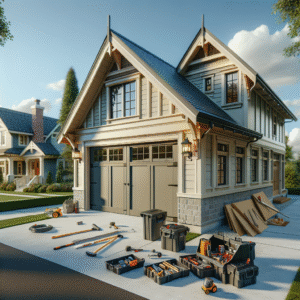Deciding Between Roof Replacement or Repair: A Comprehensive Guide for North American Homeowners
Maintaining a durable and efficient roof is essential for homeowners in the U.S. and Canada. The varied climates—from harsh winters and scorching summers to coastal salt spray and high winds—can take a toll on your roof. This guide is designed to help you navigate the crucial decision of whether to repair minor damages or undertake a full roof replacement. We will explore the signs indicating your roof needs attention, the costs and benefits of each option, and provide you with the knowledge to make an informed decision that ensures the safety and longevity of your home.
Understanding Common Roof Problems in North America
North America’s diverse weather conditions can cause various issues for roofs. Here are some common problems homeowners may encounter:
Leaks: Often caused by missing or broken shingles, cracks in roofing materials, or poor sealing around vents and chimneys, leaks are a frequent issue that can lead to significant water damage inside your home.
Weather Damage: Harsh weather conditions, including high winds, heavy snow, and ice, can cause shingles to become dislodged or damaged. Coastal areas face additional challenges from salty air, which can accelerate the corrosion of metal roofs.
Wear and Tear: Over time, exposure to the elements—sunlight, rain, wind, and temperature fluctuations—will degrade roofing materials. Regular maintenance is essential to mitigate this natural wear and tear.
Structural Problems: Poor installation or lack of maintenance can lead to structural issues that compromise your roof’s integrity. Problems such as inadequate support, improper material use, or design flaws can result in serious damage.
Identifying Signs Your Roof Needs Attention
Proactively identifying roof problems can save you time and money. Look out for the following signs:
External Indicators:
- Missing or Damaged Shingles: Shingles that are cracked, curled, or missing indicate potential problems.
- Moss and Algae Growth: While they may seem harmless, moss and algae can retain moisture, leading to rot and damage.
- Rust: For metal roofs, rust is a clear sign of deterioration, especially in coastal areas.
Internal Indicators:
- Water Stains: Stains on ceilings or walls suggest water infiltration.
- Mold: Mold growth inside your home often points to excess moisture from roof leaks.
- Light Penetration: If you see light coming through the roof boards, it means there are gaps needing immediate attention.
Patching Versus Replacing Your Roof: Key Considerations
When faced with roof damage, deciding between patching and replacing requires careful consideration of several factors:
Extent of Damage:
- Minor Damage: Small, isolated issues such as a few missing shingles can often be patched effectively.
- Major Damage: Widespread problems like extensive leaks, significant structural issues, or damage from severe weather typically warrant a full replacement.
Cost Factors:
- Short-Term Costs: Patching is usually less expensive initially, requiring fewer materials and labor.
- Long-Term Costs: While replacing a roof has higher upfront costs, it can be more economical over time by avoiding frequent repairs and improving energy efficiency.
Roof Age:
- Lifespan of Materials: Asphalt shingles typically last 15-30 years, metal roofs 30-50 years, and clay or concrete tiles can exceed 50 years. If your roof is nearing the end of its lifespan, replacement might be the better option.
Future Home Plans:
- Long-Term Residence: If you plan to stay in your home for many years, investing in a new roof can increase comfort and property value.
- Short-Term Plans: If you expect to move soon, patching may suffice to address immediate issues without the expense of a full replacement.
Advantages and Disadvantages of Each Option
Understanding the pros and cons of patching versus replacing your roof can help in making the right decision:
Patching:
- Advantages: Cost-effective, quick, and less disruptive. Suitable for minor, localized damage.
- Disadvantages: Often a temporary fix. May not match existing materials, potentially leading to aesthetic and structural inconsistencies.
Replacing:
- Advantages: Comprehensive solution that addresses all issues, improves energy efficiency, and increases home value. Uses modern materials that may offer better durability and insulation.
- Disadvantages: Higher initial cost and more disruptive. Requires significant time and planning.
Making an Informed Decision
Choosing between patching and replacing your roof depends on the damage extent, costs, roof age, and future plans. Here’s how to decide:
Inspecting Your Roof:
- Safety First: Use proper safety gear, including a sturdy ladder and non-slip shoes. Avoid walking on the roof if possible.
- What to Look For: Check for missing, cracked, or curled shingles, rust spots, moss or algae growth, clogged gutters, and damage around vents and chimneys.
Consulting Professionals:
- When to Call Experts: For extensive damage, structural issues, or if you’re unsure about the extent of the problem, professional roofers can provide detailed assessments and recommendations.
- Choosing a Contractor: Seek recommendations, check credentials and reviews, and get multiple quotes to find a reliable contractor.
Preparing for Roof Repairs or Replacement
Proper planning can make your roofing project smoother:
Budgeting:
- Assessment: Get inspections and multiple quotes to understand costs.
- Planning for Extras: Include a 15-20% buffer in your budget for unforeseen expenses.
Saving Money:
- Material Choice: Select cost-effective, durable materials.
- Off-Season Work: Schedule projects in late fall or winter for potential savings.
- Insurance Claims: Check if your homeowner’s insurance covers damage from natural events.
Project Preparation:
- Safety and Access: Ensure clear access for workers and keep children and pets away.
- Protect Belongings: Remove or cover items in the attic and fragile items inside the home.
- Communication: Stay in regular contact with your contractor to address any concerns and stay informed on progress.
By understanding these factors and preparing accordingly, you can ensure your roof repair or replacement project is executed smoothly, stays within budget, and results in a durable, high-quality roof over your home.








